Impact of Basel III Capital and Liquidity on Bank Lending: A Study
VerifiedAdded on 2023/01/09
|17
|5692
|1
Report
AI Summary
This report delves into the significant changes in bank lending practices resulting from the implementation of Basel III capital and liquidity requirements. It begins by introducing the core concepts of Basel III and its objectives, focusing on how these regulations aim to enhance financial stability and mitigate risks. The report then explores the specific measures introduced by Basel III, including increased capital adequacy ratios and liquidity coverage ratios, and their impact on bank operations. A key aspect of the analysis involves examining how these changes have affected bank lending, particularly in the aftermath of the 2008 financial crisis. The report also reviews relevant literature to provide a comprehensive understanding of the topic and concludes with recommendations based on the findings. The report also focuses on a case study of HSBC Bank. The research methodology includes the use of a literature review to provide a comprehensive understanding of the topic.
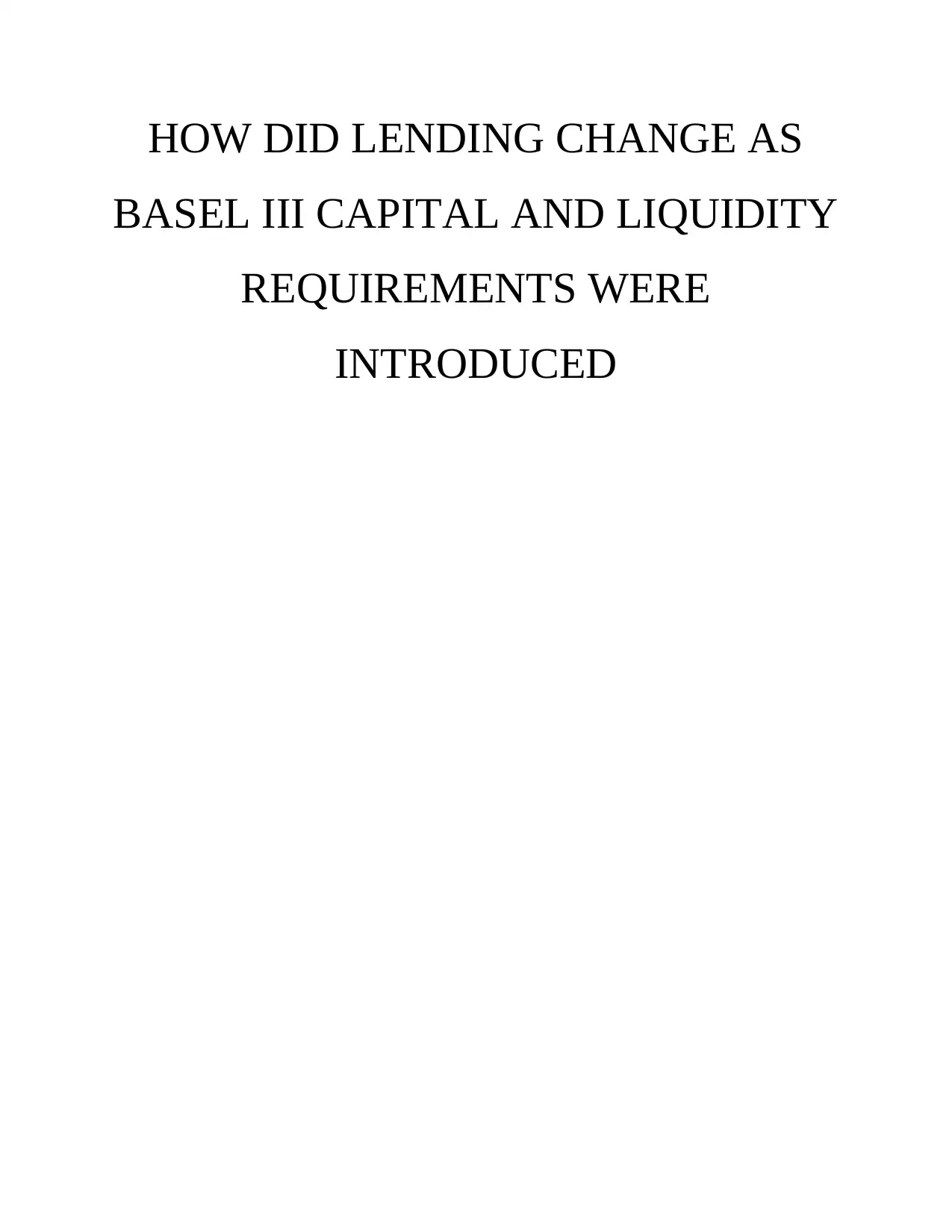
HOW DID LENDING CHANGE AS
BASEL III CAPITAL AND LIQUIDITY
REQUIREMENTS WERE
INTRODUCED
BASEL III CAPITAL AND LIQUIDITY
REQUIREMENTS WERE
INTRODUCED
Paraphrase This Document
Need a fresh take? Get an instant paraphrase of this document with our AI Paraphraser
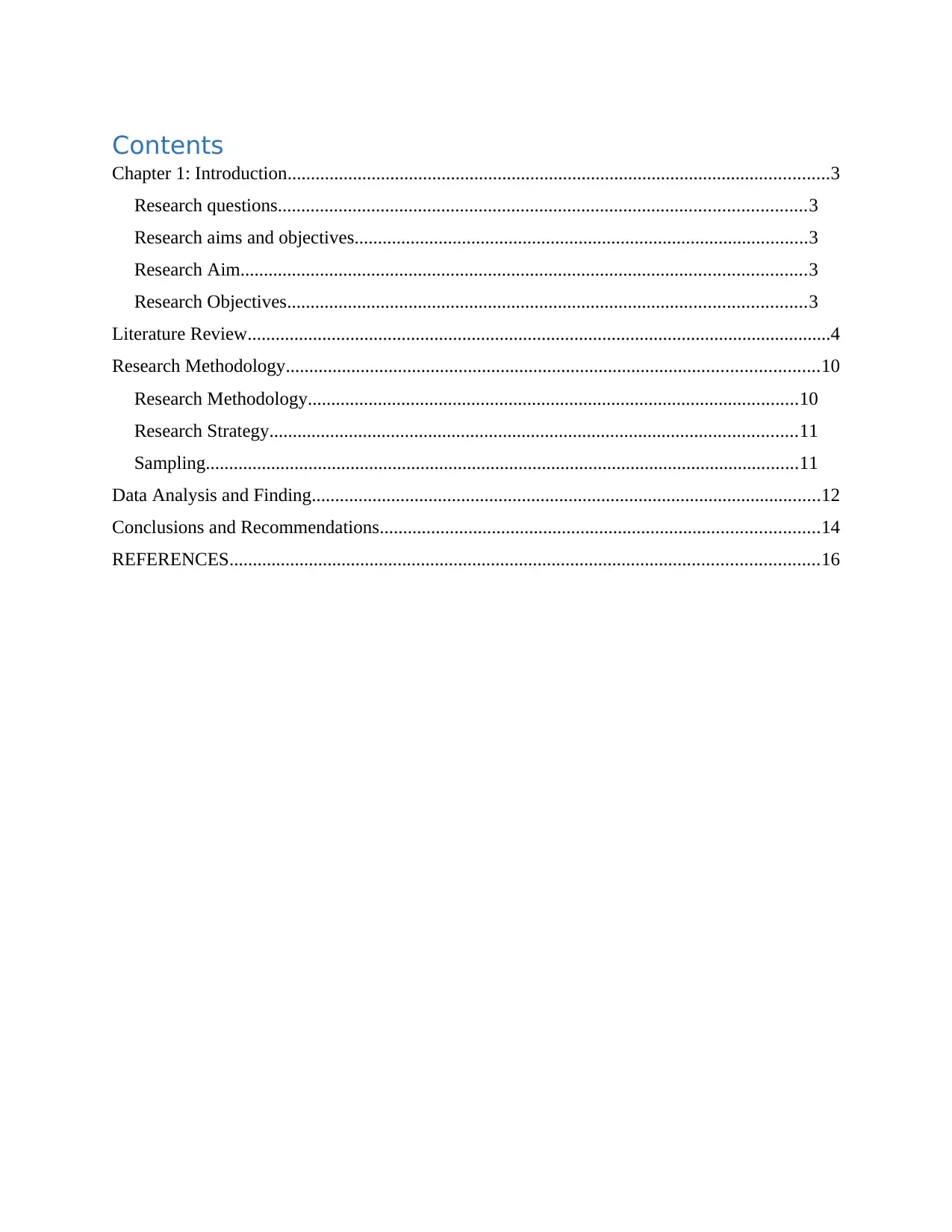
Contents
Chapter 1: Introduction....................................................................................................................3
Research questions.................................................................................................................3
Research aims and objectives.................................................................................................3
Research Aim.........................................................................................................................3
Research Objectives...............................................................................................................3
Literature Review.............................................................................................................................4
Research Methodology..................................................................................................................10
Research Methodology.........................................................................................................10
Research Strategy.................................................................................................................11
Sampling...............................................................................................................................11
Data Analysis and Finding.............................................................................................................12
Conclusions and Recommendations..............................................................................................14
REFERENCES..............................................................................................................................16
Chapter 1: Introduction....................................................................................................................3
Research questions.................................................................................................................3
Research aims and objectives.................................................................................................3
Research Aim.........................................................................................................................3
Research Objectives...............................................................................................................3
Literature Review.............................................................................................................................4
Research Methodology..................................................................................................................10
Research Methodology.........................................................................................................10
Research Strategy.................................................................................................................11
Sampling...............................................................................................................................11
Data Analysis and Finding.............................................................................................................12
Conclusions and Recommendations..............................................................................................14
REFERENCES..............................................................................................................................16
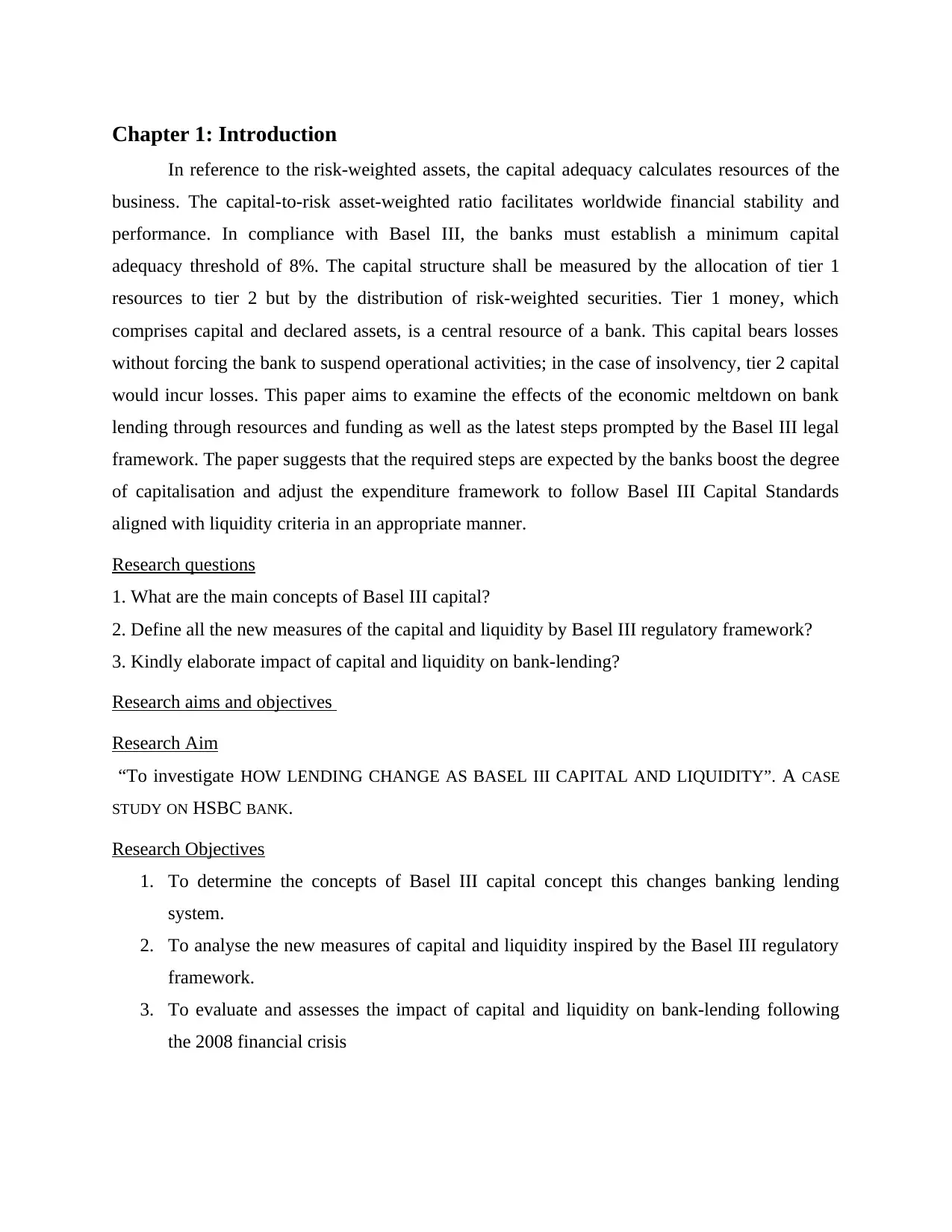
Chapter 1: Introduction
In reference to the risk-weighted assets, the capital adequacy calculates resources of the
business. The capital-to-risk asset-weighted ratio facilitates worldwide financial stability and
performance. In compliance with Basel III, the banks must establish a minimum capital
adequacy threshold of 8%. The capital structure shall be measured by the allocation of tier 1
resources to tier 2 but by the distribution of risk-weighted securities. Tier 1 money, which
comprises capital and declared assets, is a central resource of a bank. This capital bears losses
without forcing the bank to suspend operational activities; in the case of insolvency, tier 2 capital
would incur losses. This paper aims to examine the effects of the economic meltdown on bank
lending through resources and funding as well as the latest steps prompted by the Basel III legal
framework. The paper suggests that the required steps are expected by the banks boost the degree
of capitalisation and adjust the expenditure framework to follow Basel III Capital Standards
aligned with liquidity criteria in an appropriate manner.
Research questions
1. What are the main concepts of Basel III capital?
2. Define all the new measures of the capital and liquidity by Basel III regulatory framework?
3. Kindly elaborate impact of capital and liquidity on bank-lending?
Research aims and objectives
Research Aim
“To investigate HOW LENDING CHANGE AS BASEL III CAPITAL AND LIQUIDITY”. A CASE
STUDY ON HSBC BANK.
Research Objectives
1. To determine the concepts of Basel III capital concept this changes banking lending
system.
2. To analyse the new measures of capital and liquidity inspired by the Basel III regulatory
framework.
3. To evaluate and assesses the impact of capital and liquidity on bank-lending following
the 2008 financial crisis
In reference to the risk-weighted assets, the capital adequacy calculates resources of the
business. The capital-to-risk asset-weighted ratio facilitates worldwide financial stability and
performance. In compliance with Basel III, the banks must establish a minimum capital
adequacy threshold of 8%. The capital structure shall be measured by the allocation of tier 1
resources to tier 2 but by the distribution of risk-weighted securities. Tier 1 money, which
comprises capital and declared assets, is a central resource of a bank. This capital bears losses
without forcing the bank to suspend operational activities; in the case of insolvency, tier 2 capital
would incur losses. This paper aims to examine the effects of the economic meltdown on bank
lending through resources and funding as well as the latest steps prompted by the Basel III legal
framework. The paper suggests that the required steps are expected by the banks boost the degree
of capitalisation and adjust the expenditure framework to follow Basel III Capital Standards
aligned with liquidity criteria in an appropriate manner.
Research questions
1. What are the main concepts of Basel III capital?
2. Define all the new measures of the capital and liquidity by Basel III regulatory framework?
3. Kindly elaborate impact of capital and liquidity on bank-lending?
Research aims and objectives
Research Aim
“To investigate HOW LENDING CHANGE AS BASEL III CAPITAL AND LIQUIDITY”. A CASE
STUDY ON HSBC BANK.
Research Objectives
1. To determine the concepts of Basel III capital concept this changes banking lending
system.
2. To analyse the new measures of capital and liquidity inspired by the Basel III regulatory
framework.
3. To evaluate and assesses the impact of capital and liquidity on bank-lending following
the 2008 financial crisis
⊘ This is a preview!⊘
Do you want full access?
Subscribe today to unlock all pages.

Trusted by 1+ million students worldwide
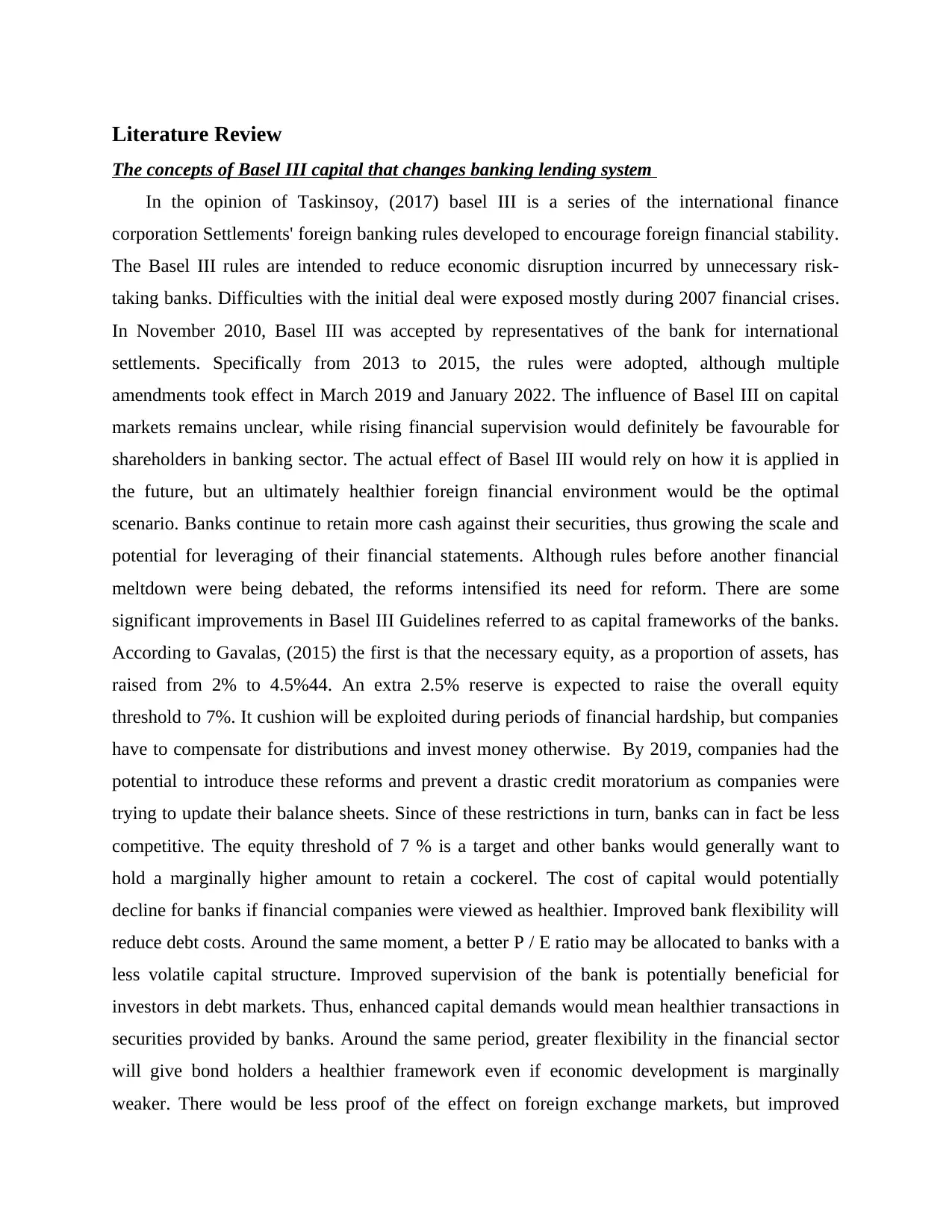
Literature Review
The concepts of Basel III capital that changes banking lending system
In the opinion of Taskinsoy, (2017) basel III is a series of the international finance
corporation Settlements' foreign banking rules developed to encourage foreign financial stability.
The Basel III rules are intended to reduce economic disruption incurred by unnecessary risk-
taking banks. Difficulties with the initial deal were exposed mostly during 2007 financial crises.
In November 2010, Basel III was accepted by representatives of the bank for international
settlements. Specifically from 2013 to 2015, the rules were adopted, although multiple
amendments took effect in March 2019 and January 2022. The influence of Basel III on capital
markets remains unclear, while rising financial supervision would definitely be favourable for
shareholders in banking sector. The actual effect of Basel III would rely on how it is applied in
the future, but an ultimately healthier foreign financial environment would be the optimal
scenario. Banks continue to retain more cash against their securities, thus growing the scale and
potential for leveraging of their financial statements. Although rules before another financial
meltdown were being debated, the reforms intensified its need for reform. There are some
significant improvements in Basel III Guidelines referred to as capital frameworks of the banks.
According to Gavalas, (2015) the first is that the necessary equity, as a proportion of assets, has
raised from 2% to 4.5%44. An extra 2.5% reserve is expected to raise the overall equity
threshold to 7%. It cushion will be exploited during periods of financial hardship, but companies
have to compensate for distributions and invest money otherwise. By 2019, companies had the
potential to introduce these reforms and prevent a drastic credit moratorium as companies were
trying to update their balance sheets. Since of these restrictions in turn, banks can in fact be less
competitive. The equity threshold of 7 % is a target and other banks would generally want to
hold a marginally higher amount to retain a cockerel. The cost of capital would potentially
decline for banks if financial companies were viewed as healthier. Improved bank flexibility will
reduce debt costs. Around the same moment, a better P / E ratio may be allocated to banks with a
less volatile capital structure. Improved supervision of the bank is potentially beneficial for
investors in debt markets. Thus, enhanced capital demands would mean healthier transactions in
securities provided by banks. Around the same period, greater flexibility in the financial sector
will give bond holders a healthier framework even if economic development is marginally
weaker. There would be less proof of the effect on foreign exchange markets, but improved
The concepts of Basel III capital that changes banking lending system
In the opinion of Taskinsoy, (2017) basel III is a series of the international finance
corporation Settlements' foreign banking rules developed to encourage foreign financial stability.
The Basel III rules are intended to reduce economic disruption incurred by unnecessary risk-
taking banks. Difficulties with the initial deal were exposed mostly during 2007 financial crises.
In November 2010, Basel III was accepted by representatives of the bank for international
settlements. Specifically from 2013 to 2015, the rules were adopted, although multiple
amendments took effect in March 2019 and January 2022. The influence of Basel III on capital
markets remains unclear, while rising financial supervision would definitely be favourable for
shareholders in banking sector. The actual effect of Basel III would rely on how it is applied in
the future, but an ultimately healthier foreign financial environment would be the optimal
scenario. Banks continue to retain more cash against their securities, thus growing the scale and
potential for leveraging of their financial statements. Although rules before another financial
meltdown were being debated, the reforms intensified its need for reform. There are some
significant improvements in Basel III Guidelines referred to as capital frameworks of the banks.
According to Gavalas, (2015) the first is that the necessary equity, as a proportion of assets, has
raised from 2% to 4.5%44. An extra 2.5% reserve is expected to raise the overall equity
threshold to 7%. It cushion will be exploited during periods of financial hardship, but companies
have to compensate for distributions and invest money otherwise. By 2019, companies had the
potential to introduce these reforms and prevent a drastic credit moratorium as companies were
trying to update their balance sheets. Since of these restrictions in turn, banks can in fact be less
competitive. The equity threshold of 7 % is a target and other banks would generally want to
hold a marginally higher amount to retain a cockerel. The cost of capital would potentially
decline for banks if financial companies were viewed as healthier. Improved bank flexibility will
reduce debt costs. Around the same moment, a better P / E ratio may be allocated to banks with a
less volatile capital structure. Improved supervision of the bank is potentially beneficial for
investors in debt markets. Thus, enhanced capital demands would mean healthier transactions in
securities provided by banks. Around the same period, greater flexibility in the financial sector
will give bond holders a healthier framework even if economic development is marginally
weaker. There would be less proof of the effect on foreign exchange markets, but improved
Paraphrase This Document
Need a fresh take? Get an instant paraphrase of this document with our AI Paraphraser

foreign financial stability would encourage investors in those markets to rely on certain
considerations and concentrate less on the perceived performance of the banking sector in each
country. Ultimately, Basel III has an unpredictable effect on financial markets. When investors
favour better financial stability over credit-driven marginally further growth, equity prices are
projected to gain from Basel III. In turn, strong financial stability would enable investors to
concentrate greater on specific firms or markets and less worried with the economic climate or
possible financial crisis. As per review of Naceur, Marton and Roulet, (2018), capital
requirements may reduce the risk of potential financial problems; they can also limit future
economic development. It may be because money supply and leasing were among the key factors
of the new system of economic development. So, any legislation aimed at limiting credit access
could, at least partially, impede economic development. In addition, it must imply more
prosperity and a reduced likelihood of 2008 and 2009 incidents that regulators, stock market
investors, and average citizens embrace marginally slower economic development. Basel III will
contribute to a healthier financial environment and to a limited degree inhibit potential economic
development. The effect on investors is potentially diverse; nevertheless, it will contribute to
better markets on bond holders and more stability for holders in the equity market. Knowing the
Basel III rules helps investors to grasp the monetary system and help them articulate economic
and financial perspectives on the integrity of the world banking framework and environment.
New measures of capital and liquidity inspired by the Basel III regulatory framework
In the opinion of Dermine, (2015) a core feature of the Basel III reaction to the banking
crisis is really the Basel III system. The study discusses a range of limitations in the economic
framework pre-crisis and offers the foundation for a stronger financial regime to prevent the
emergence of structural vulnerabilities. The mechanism would allow the financial sector across
the business downturn to sustain the financial sector. During the beginning of Basel III
legislation, the following elements of the regulatory system were strengthened:
Increased bank profitability by relying more on the lower shares, as a Common Equity
Tier 1 (CET1), in order to withstand losses;
To raise the amount of capital responsibility for ensuring banks are adequately immune to
stressful losses;
considerations and concentrate less on the perceived performance of the banking sector in each
country. Ultimately, Basel III has an unpredictable effect on financial markets. When investors
favour better financial stability over credit-driven marginally further growth, equity prices are
projected to gain from Basel III. In turn, strong financial stability would enable investors to
concentrate greater on specific firms or markets and less worried with the economic climate or
possible financial crisis. As per review of Naceur, Marton and Roulet, (2018), capital
requirements may reduce the risk of potential financial problems; they can also limit future
economic development. It may be because money supply and leasing were among the key factors
of the new system of economic development. So, any legislation aimed at limiting credit access
could, at least partially, impede economic development. In addition, it must imply more
prosperity and a reduced likelihood of 2008 and 2009 incidents that regulators, stock market
investors, and average citizens embrace marginally slower economic development. Basel III will
contribute to a healthier financial environment and to a limited degree inhibit potential economic
development. The effect on investors is potentially diverse; nevertheless, it will contribute to
better markets on bond holders and more stability for holders in the equity market. Knowing the
Basel III rules helps investors to grasp the monetary system and help them articulate economic
and financial perspectives on the integrity of the world banking framework and environment.
New measures of capital and liquidity inspired by the Basel III regulatory framework
In the opinion of Dermine, (2015) a core feature of the Basel III reaction to the banking
crisis is really the Basel III system. The study discusses a range of limitations in the economic
framework pre-crisis and offers the foundation for a stronger financial regime to prevent the
emergence of structural vulnerabilities. The mechanism would allow the financial sector across
the business downturn to sustain the financial sector. During the beginning of Basel III
legislation, the following elements of the regulatory system were strengthened:
Increased bank profitability by relying more on the lower shares, as a Common Equity
Tier 1 (CET1), in order to withstand losses;
To raise the amount of capital responsibility for ensuring banks are adequately immune to
stressful losses;
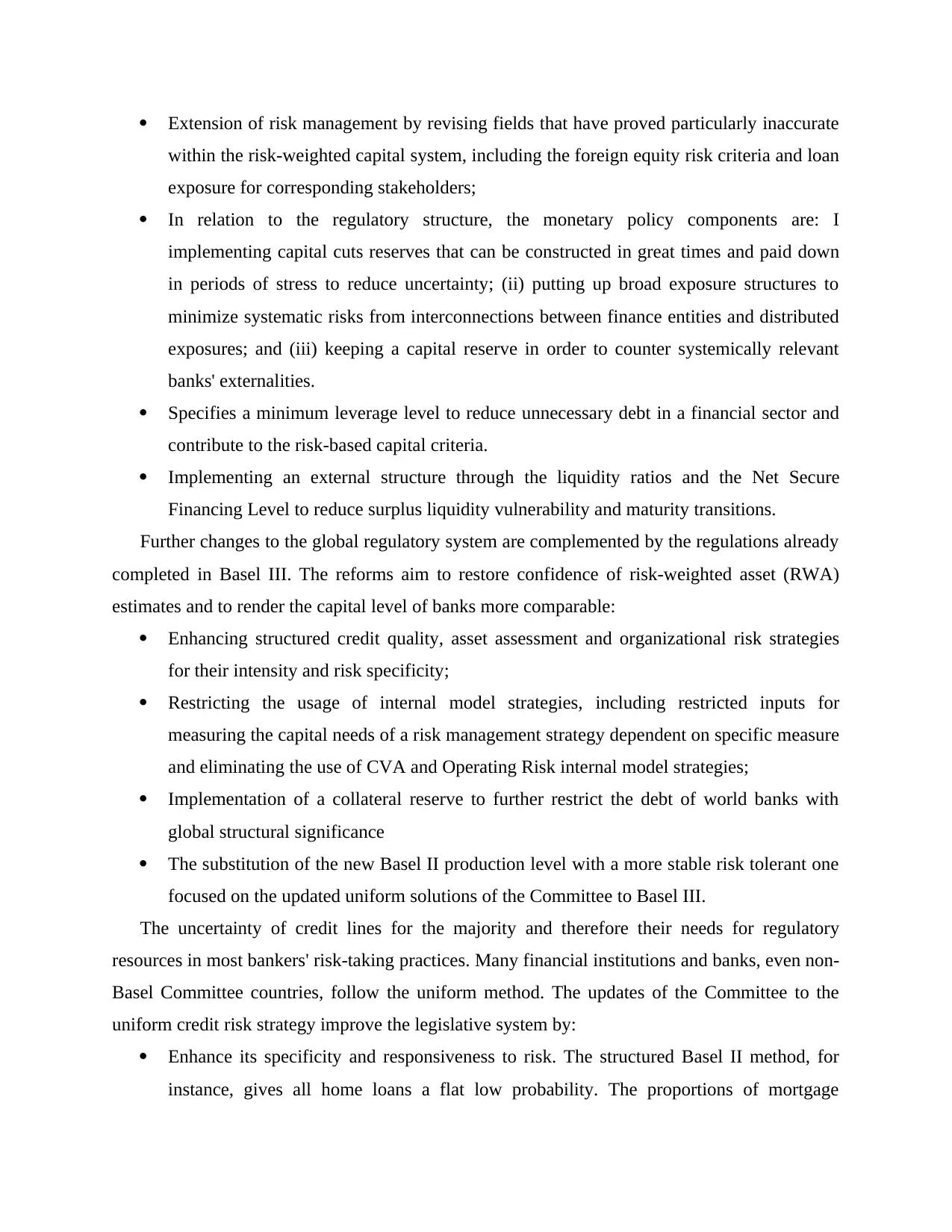
Extension of risk management by revising fields that have proved particularly inaccurate
within the risk-weighted capital system, including the foreign equity risk criteria and loan
exposure for corresponding stakeholders;
In relation to the regulatory structure, the monetary policy components are: I
implementing capital cuts reserves that can be constructed in great times and paid down
in periods of stress to reduce uncertainty; (ii) putting up broad exposure structures to
minimize systematic risks from interconnections between finance entities and distributed
exposures; and (iii) keeping a capital reserve in order to counter systemically relevant
banks' externalities.
Specifies a minimum leverage level to reduce unnecessary debt in a financial sector and
contribute to the risk-based capital criteria.
Implementing an external structure through the liquidity ratios and the Net Secure
Financing Level to reduce surplus liquidity vulnerability and maturity transitions.
Further changes to the global regulatory system are complemented by the regulations already
completed in Basel III. The reforms aim to restore confidence of risk-weighted asset (RWA)
estimates and to render the capital level of banks more comparable:
Enhancing structured credit quality, asset assessment and organizational risk strategies
for their intensity and risk specificity;
Restricting the usage of internal model strategies, including restricted inputs for
measuring the capital needs of a risk management strategy dependent on specific measure
and eliminating the use of CVA and Operating Risk internal model strategies;
Implementation of a collateral reserve to further restrict the debt of world banks with
global structural significance
The substitution of the new Basel II production level with a more stable risk tolerant one
focused on the updated uniform solutions of the Committee to Basel III.
The uncertainty of credit lines for the majority and therefore their needs for regulatory
resources in most bankers' risk-taking practices. Many financial institutions and banks, even non-
Basel Committee countries, follow the uniform method. The updates of the Committee to the
uniform credit risk strategy improve the legislative system by:
Enhance its specificity and responsiveness to risk. The structured Basel II method, for
instance, gives all home loans a flat low probability. The proportions of mortgage
within the risk-weighted capital system, including the foreign equity risk criteria and loan
exposure for corresponding stakeholders;
In relation to the regulatory structure, the monetary policy components are: I
implementing capital cuts reserves that can be constructed in great times and paid down
in periods of stress to reduce uncertainty; (ii) putting up broad exposure structures to
minimize systematic risks from interconnections between finance entities and distributed
exposures; and (iii) keeping a capital reserve in order to counter systemically relevant
banks' externalities.
Specifies a minimum leverage level to reduce unnecessary debt in a financial sector and
contribute to the risk-based capital criteria.
Implementing an external structure through the liquidity ratios and the Net Secure
Financing Level to reduce surplus liquidity vulnerability and maturity transitions.
Further changes to the global regulatory system are complemented by the regulations already
completed in Basel III. The reforms aim to restore confidence of risk-weighted asset (RWA)
estimates and to render the capital level of banks more comparable:
Enhancing structured credit quality, asset assessment and organizational risk strategies
for their intensity and risk specificity;
Restricting the usage of internal model strategies, including restricted inputs for
measuring the capital needs of a risk management strategy dependent on specific measure
and eliminating the use of CVA and Operating Risk internal model strategies;
Implementation of a collateral reserve to further restrict the debt of world banks with
global structural significance
The substitution of the new Basel II production level with a more stable risk tolerant one
focused on the updated uniform solutions of the Committee to Basel III.
The uncertainty of credit lines for the majority and therefore their needs for regulatory
resources in most bankers' risk-taking practices. Many financial institutions and banks, even non-
Basel Committee countries, follow the uniform method. The updates of the Committee to the
uniform credit risk strategy improve the legislative system by:
Enhance its specificity and responsiveness to risk. The structured Basel II method, for
instance, gives all home loans a flat low probability. The proportions of mortgage
⊘ This is a preview!⊘
Do you want full access?
Subscribe today to unlock all pages.

Trusted by 1+ million students worldwide
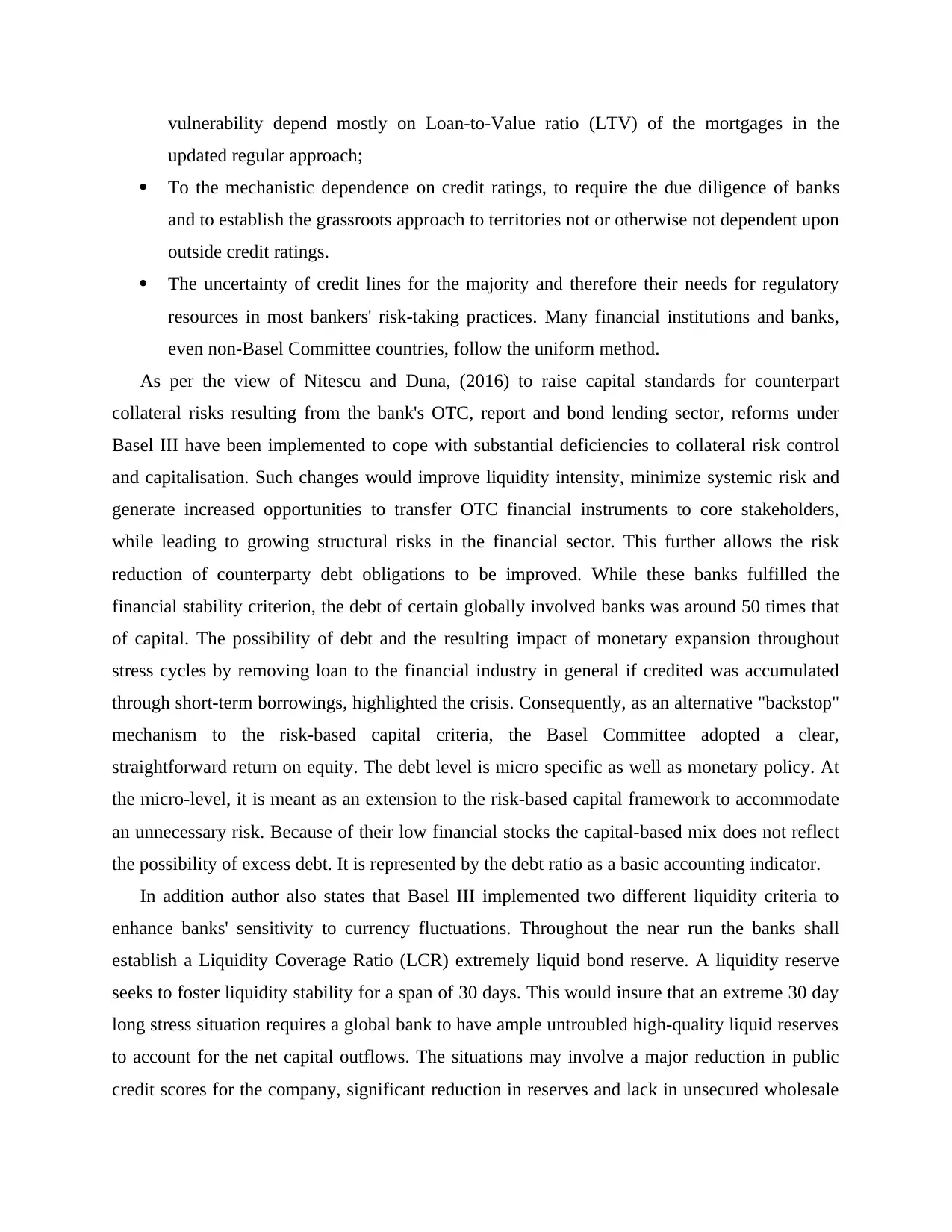
vulnerability depend mostly on Loan-to-Value ratio (LTV) of the mortgages in the
updated regular approach;
To the mechanistic dependence on credit ratings, to require the due diligence of banks
and to establish the grassroots approach to territories not or otherwise not dependent upon
outside credit ratings.
The uncertainty of credit lines for the majority and therefore their needs for regulatory
resources in most bankers' risk-taking practices. Many financial institutions and banks,
even non-Basel Committee countries, follow the uniform method.
As per the view of Nitescu and Duna, (2016) to raise capital standards for counterpart
collateral risks resulting from the bank's OTC, report and bond lending sector, reforms under
Basel III have been implemented to cope with substantial deficiencies to collateral risk control
and capitalisation. Such changes would improve liquidity intensity, minimize systemic risk and
generate increased opportunities to transfer OTC financial instruments to core stakeholders,
while leading to growing structural risks in the financial sector. This further allows the risk
reduction of counterparty debt obligations to be improved. While these banks fulfilled the
financial stability criterion, the debt of certain globally involved banks was around 50 times that
of capital. The possibility of debt and the resulting impact of monetary expansion throughout
stress cycles by removing loan to the financial industry in general if credited was accumulated
through short-term borrowings, highlighted the crisis. Consequently, as an alternative "backstop"
mechanism to the risk-based capital criteria, the Basel Committee adopted a clear,
straightforward return on equity. The debt level is micro specific as well as monetary policy. At
the micro-level, it is meant as an extension to the risk-based capital framework to accommodate
an unnecessary risk. Because of their low financial stocks the capital-based mix does not reflect
the possibility of excess debt. It is represented by the debt ratio as a basic accounting indicator.
In addition author also states that Basel III implemented two different liquidity criteria to
enhance banks' sensitivity to currency fluctuations. Throughout the near run the banks shall
establish a Liquidity Coverage Ratio (LCR) extremely liquid bond reserve. A liquidity reserve
seeks to foster liquidity stability for a span of 30 days. This would insure that an extreme 30 day
long stress situation requires a global bank to have ample untroubled high-quality liquid reserves
to account for the net capital outflows. The situations may involve a major reduction in public
credit scores for the company, significant reduction in reserves and lack in unsecured wholesale
updated regular approach;
To the mechanistic dependence on credit ratings, to require the due diligence of banks
and to establish the grassroots approach to territories not or otherwise not dependent upon
outside credit ratings.
The uncertainty of credit lines for the majority and therefore their needs for regulatory
resources in most bankers' risk-taking practices. Many financial institutions and banks,
even non-Basel Committee countries, follow the uniform method.
As per the view of Nitescu and Duna, (2016) to raise capital standards for counterpart
collateral risks resulting from the bank's OTC, report and bond lending sector, reforms under
Basel III have been implemented to cope with substantial deficiencies to collateral risk control
and capitalisation. Such changes would improve liquidity intensity, minimize systemic risk and
generate increased opportunities to transfer OTC financial instruments to core stakeholders,
while leading to growing structural risks in the financial sector. This further allows the risk
reduction of counterparty debt obligations to be improved. While these banks fulfilled the
financial stability criterion, the debt of certain globally involved banks was around 50 times that
of capital. The possibility of debt and the resulting impact of monetary expansion throughout
stress cycles by removing loan to the financial industry in general if credited was accumulated
through short-term borrowings, highlighted the crisis. Consequently, as an alternative "backstop"
mechanism to the risk-based capital criteria, the Basel Committee adopted a clear,
straightforward return on equity. The debt level is micro specific as well as monetary policy. At
the micro-level, it is meant as an extension to the risk-based capital framework to accommodate
an unnecessary risk. Because of their low financial stocks the capital-based mix does not reflect
the possibility of excess debt. It is represented by the debt ratio as a basic accounting indicator.
In addition author also states that Basel III implemented two different liquidity criteria to
enhance banks' sensitivity to currency fluctuations. Throughout the near run the banks shall
establish a Liquidity Coverage Ratio (LCR) extremely liquid bond reserve. A liquidity reserve
seeks to foster liquidity stability for a span of 30 days. This would insure that an extreme 30 day
long stress situation requires a global bank to have ample untroubled high-quality liquid reserves
to account for the net capital outflows. The situations may involve a major reduction in public
credit scores for the company, significant reduction in reserves and lack in unsecured wholesale
Paraphrase This Document
Need a fresh take? Get an instant paraphrase of this document with our AI Paraphraser
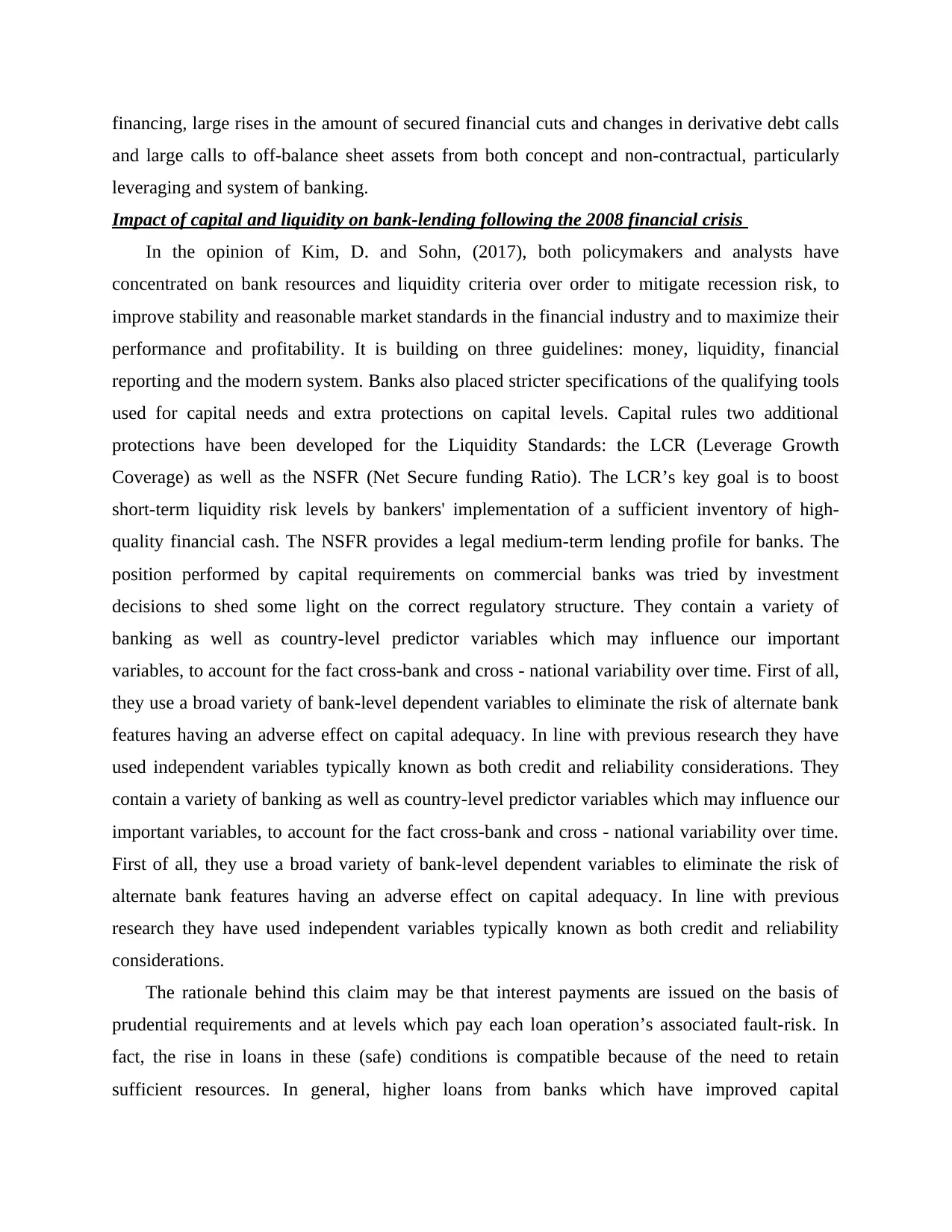
financing, large rises in the amount of secured financial cuts and changes in derivative debt calls
and large calls to off-balance sheet assets from both concept and non-contractual, particularly
leveraging and system of banking.
Impact of capital and liquidity on bank-lending following the 2008 financial crisis
In the opinion of Kim, D. and Sohn, (2017), both policymakers and analysts have
concentrated on bank resources and liquidity criteria over order to mitigate recession risk, to
improve stability and reasonable market standards in the financial industry and to maximize their
performance and profitability. It is building on three guidelines: money, liquidity, financial
reporting and the modern system. Banks also placed stricter specifications of the qualifying tools
used for capital needs and extra protections on capital levels. Capital rules two additional
protections have been developed for the Liquidity Standards: the LCR (Leverage Growth
Coverage) as well as the NSFR (Net Secure funding Ratio). The LCR’s key goal is to boost
short-term liquidity risk levels by bankers' implementation of a sufficient inventory of high-
quality financial cash. The NSFR provides a legal medium-term lending profile for banks. The
position performed by capital requirements on commercial banks was tried by investment
decisions to shed some light on the correct regulatory structure. They contain a variety of
banking as well as country-level predictor variables which may influence our important
variables, to account for the fact cross-bank and cross - national variability over time. First of all,
they use a broad variety of bank-level dependent variables to eliminate the risk of alternate bank
features having an adverse effect on capital adequacy. In line with previous research they have
used independent variables typically known as both credit and reliability considerations. They
contain a variety of banking as well as country-level predictor variables which may influence our
important variables, to account for the fact cross-bank and cross - national variability over time.
First of all, they use a broad variety of bank-level dependent variables to eliminate the risk of
alternate bank features having an adverse effect on capital adequacy. In line with previous
research they have used independent variables typically known as both credit and reliability
considerations.
The rationale behind this claim may be that interest payments are issued on the basis of
prudential requirements and at levels which pay each loan operation’s associated fault-risk. In
fact, the rise in loans in these (safe) conditions is compatible because of the need to retain
sufficient resources. In general, higher loans from banks which have improved capital
and large calls to off-balance sheet assets from both concept and non-contractual, particularly
leveraging and system of banking.
Impact of capital and liquidity on bank-lending following the 2008 financial crisis
In the opinion of Kim, D. and Sohn, (2017), both policymakers and analysts have
concentrated on bank resources and liquidity criteria over order to mitigate recession risk, to
improve stability and reasonable market standards in the financial industry and to maximize their
performance and profitability. It is building on three guidelines: money, liquidity, financial
reporting and the modern system. Banks also placed stricter specifications of the qualifying tools
used for capital needs and extra protections on capital levels. Capital rules two additional
protections have been developed for the Liquidity Standards: the LCR (Leverage Growth
Coverage) as well as the NSFR (Net Secure funding Ratio). The LCR’s key goal is to boost
short-term liquidity risk levels by bankers' implementation of a sufficient inventory of high-
quality financial cash. The NSFR provides a legal medium-term lending profile for banks. The
position performed by capital requirements on commercial banks was tried by investment
decisions to shed some light on the correct regulatory structure. They contain a variety of
banking as well as country-level predictor variables which may influence our important
variables, to account for the fact cross-bank and cross - national variability over time. First of all,
they use a broad variety of bank-level dependent variables to eliminate the risk of alternate bank
features having an adverse effect on capital adequacy. In line with previous research they have
used independent variables typically known as both credit and reliability considerations. They
contain a variety of banking as well as country-level predictor variables which may influence our
important variables, to account for the fact cross-bank and cross - national variability over time.
First of all, they use a broad variety of bank-level dependent variables to eliminate the risk of
alternate bank features having an adverse effect on capital adequacy. In line with previous
research they have used independent variables typically known as both credit and reliability
considerations.
The rationale behind this claim may be that interest payments are issued on the basis of
prudential requirements and at levels which pay each loan operation’s associated fault-risk. In
fact, the rise in loans in these (safe) conditions is compatible because of the need to retain
sufficient resources. In general, higher loans from banks which have improved capital

requirements ratios are encouraging more banks in such a sustainable and secure manner. New
loans thus appear to be a particular mechanism whereby policy allows investors to lower their
opportunities for risk-taking and thus boost bank's profitability. Therefore, this data indicate that
in economies with a stronger degree of security for creditors' rights the position of Basel III's
liquidity and funding criteria is more important in rising bank risk-taking stimulation by
improvements in loan production. Generally, however, it seems that the level of security of
creditor interests is higher in the sense of capital requirements function easier. The finding may
be aligned with the literature suggesting that banks will aggressively grow into non-traditional
companies. The relationship findings with the anticipated benefit of credit development therefore
imply that in places with cheaper constraints on non-traditional banking practices, the main
function of the expanded lending would occur to maintain stability. In a similar way, our data are
compatible with the more favourable direction played by capital adequacy in fostering higher
banking stability via the borrowing channel in areas with poor constraints on bank involvement
in non-financial corporate ownership institutional frameworks. According to D'Aurizio, Oliviero
and Romano, (2015) result again shows the positive position of Basel III's current regulatory
structure to encourage stable banking in countries with decreased constraints on bank
diversification policies and to boost financial stability. With regard to control of bank operation,
it seems that higher constraints on foreign banking operations contribute to lowers danger as we
look at the direct effects of capital adequacy conditions on stability. This study indicates it will
improve risk exposure by encouraging financial companies to grow into non-traditional
businesses. That being said, the findings also suggest that in areas with poor constraints on
foreign banking practices, the main function of expanded lending is to foster stability. This result
also illustrates the significance of encouraging banks to invest in operations other than
conventional, in order to better manage their potential risks and increase their levels of resilience.
In addition, it is necessary to remember that lawmakers will consider not just the immediate
consequences of their decisions while implementing new legislative standards, but also certain
secondary channels of transmittal that may reverse entirely the overall impact of their
disciplinary acts (Gambacorta and Shin, 2018).
loans thus appear to be a particular mechanism whereby policy allows investors to lower their
opportunities for risk-taking and thus boost bank's profitability. Therefore, this data indicate that
in economies with a stronger degree of security for creditors' rights the position of Basel III's
liquidity and funding criteria is more important in rising bank risk-taking stimulation by
improvements in loan production. Generally, however, it seems that the level of security of
creditor interests is higher in the sense of capital requirements function easier. The finding may
be aligned with the literature suggesting that banks will aggressively grow into non-traditional
companies. The relationship findings with the anticipated benefit of credit development therefore
imply that in places with cheaper constraints on non-traditional banking practices, the main
function of the expanded lending would occur to maintain stability. In a similar way, our data are
compatible with the more favourable direction played by capital adequacy in fostering higher
banking stability via the borrowing channel in areas with poor constraints on bank involvement
in non-financial corporate ownership institutional frameworks. According to D'Aurizio, Oliviero
and Romano, (2015) result again shows the positive position of Basel III's current regulatory
structure to encourage stable banking in countries with decreased constraints on bank
diversification policies and to boost financial stability. With regard to control of bank operation,
it seems that higher constraints on foreign banking operations contribute to lowers danger as we
look at the direct effects of capital adequacy conditions on stability. This study indicates it will
improve risk exposure by encouraging financial companies to grow into non-traditional
businesses. That being said, the findings also suggest that in areas with poor constraints on
foreign banking practices, the main function of expanded lending is to foster stability. This result
also illustrates the significance of encouraging banks to invest in operations other than
conventional, in order to better manage their potential risks and increase their levels of resilience.
In addition, it is necessary to remember that lawmakers will consider not just the immediate
consequences of their decisions while implementing new legislative standards, but also certain
secondary channels of transmittal that may reverse entirely the overall impact of their
disciplinary acts (Gambacorta and Shin, 2018).
⊘ This is a preview!⊘
Do you want full access?
Subscribe today to unlock all pages.

Trusted by 1+ million students worldwide

Research Methodology
Research is carried out to improve a person's awareness. It is a systematic approach to the
gathering of knowledge on a particular subject or problem. For that purpose, scientists utilize
increasing instruments and techniques, taking into consideration their expertise and information.
Another approach to reach a clear inference is the analysis technique and through the
implementation of this author. The process of how work is performed is known as a formal
methodology. Therefore, analysis methods may be used to provide researchers with guidelines
for justifying evidence or creating new hypotheses.
Research Philosophy:
Positivism requires methods which is strongly organized and offers quantifiable evidence
for more statistical study. With the aid of this researcher may calculate a significant sample size.
Positivism methodology has been used in regard to this work as it is focused on the social
context and assists in assessing the correct outcomes.
Research Approach
Deductive methodology allows confirm inference such that a true result can be inferred.
When a researcher has developed a theory and needs to ask whether the hypothesis developed
has to be used or discarded when doing analysis, the deductive method is ideally applied to the
same task. In accordance with this work, scholar is using deductive analysis methodology as this
would enable to generalize broad study subject into particular research topics.
Research Methodology
Quantitative Research:
There could be several cases where the gathered evidence and knowledge are in
qualitative form and quantitative analysis is done now to measure the issues which can be
interpreted in graphical form later. These can involve web polls, face-to-face conferences,
discussions over the phone, etc. Quantitative analysis approach was introduced in order to
perform this study as it essentially comprises of different types of standardized questions that can
be then translated into numerical tests. In fact it is simpler to clarify and evaluate.
Research is carried out to improve a person's awareness. It is a systematic approach to the
gathering of knowledge on a particular subject or problem. For that purpose, scientists utilize
increasing instruments and techniques, taking into consideration their expertise and information.
Another approach to reach a clear inference is the analysis technique and through the
implementation of this author. The process of how work is performed is known as a formal
methodology. Therefore, analysis methods may be used to provide researchers with guidelines
for justifying evidence or creating new hypotheses.
Research Philosophy:
Positivism requires methods which is strongly organized and offers quantifiable evidence
for more statistical study. With the aid of this researcher may calculate a significant sample size.
Positivism methodology has been used in regard to this work as it is focused on the social
context and assists in assessing the correct outcomes.
Research Approach
Deductive methodology allows confirm inference such that a true result can be inferred.
When a researcher has developed a theory and needs to ask whether the hypothesis developed
has to be used or discarded when doing analysis, the deductive method is ideally applied to the
same task. In accordance with this work, scholar is using deductive analysis methodology as this
would enable to generalize broad study subject into particular research topics.
Research Methodology
Quantitative Research:
There could be several cases where the gathered evidence and knowledge are in
qualitative form and quantitative analysis is done now to measure the issues which can be
interpreted in graphical form later. These can involve web polls, face-to-face conferences,
discussions over the phone, etc. Quantitative analysis approach was introduced in order to
perform this study as it essentially comprises of different types of standardized questions that can
be then translated into numerical tests. In fact it is simpler to clarify and evaluate.
Paraphrase This Document
Need a fresh take? Get an instant paraphrase of this document with our AI Paraphraser
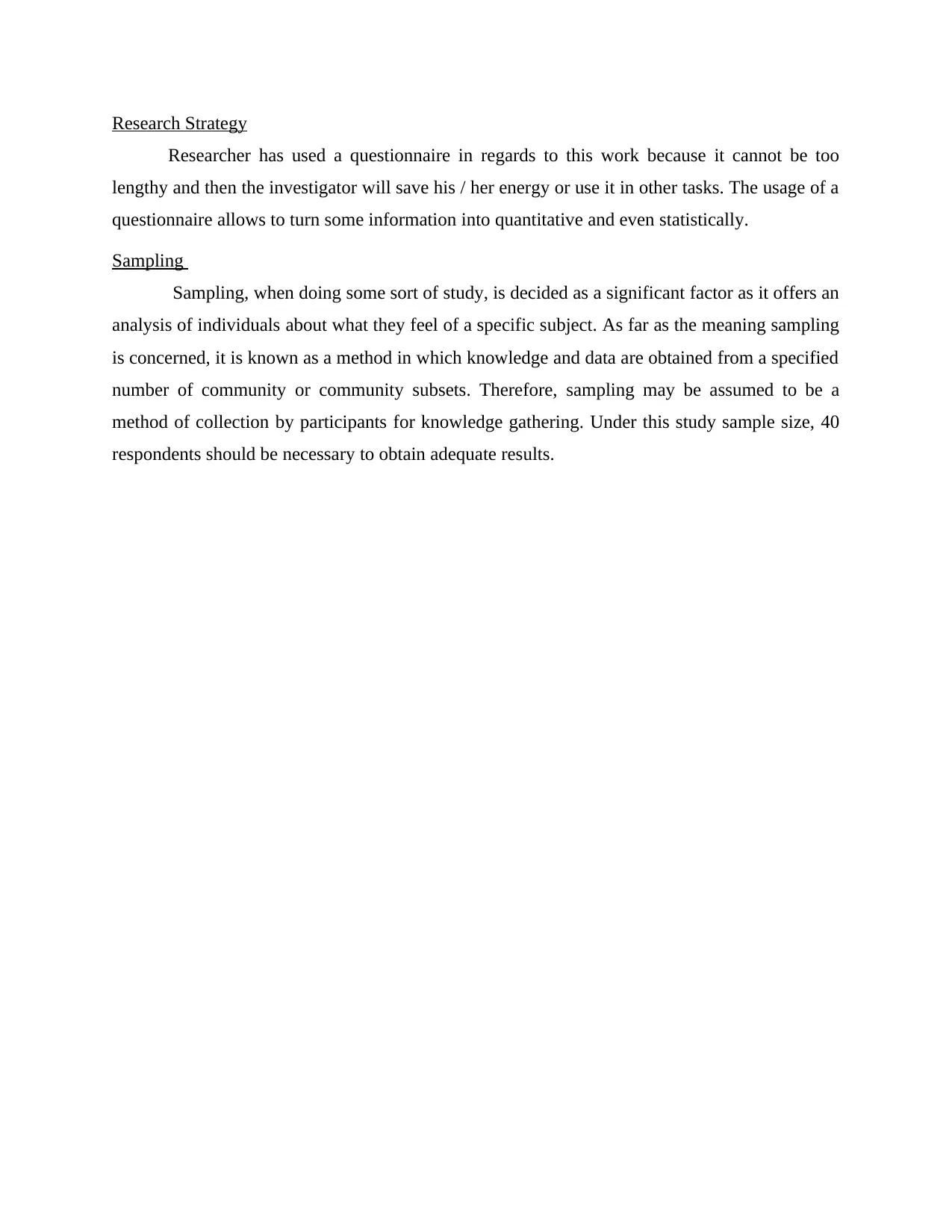
Research Strategy
Researcher has used a questionnaire in regards to this work because it cannot be too
lengthy and then the investigator will save his / her energy or use it in other tasks. The usage of a
questionnaire allows to turn some information into quantitative and even statistically.
Sampling
Sampling, when doing some sort of study, is decided as a significant factor as it offers an
analysis of individuals about what they feel of a specific subject. As far as the meaning sampling
is concerned, it is known as a method in which knowledge and data are obtained from a specified
number of community or community subsets. Therefore, sampling may be assumed to be a
method of collection by participants for knowledge gathering. Under this study sample size, 40
respondents should be necessary to obtain adequate results.
Researcher has used a questionnaire in regards to this work because it cannot be too
lengthy and then the investigator will save his / her energy or use it in other tasks. The usage of a
questionnaire allows to turn some information into quantitative and even statistically.
Sampling
Sampling, when doing some sort of study, is decided as a significant factor as it offers an
analysis of individuals about what they feel of a specific subject. As far as the meaning sampling
is concerned, it is known as a method in which knowledge and data are obtained from a specified
number of community or community subsets. Therefore, sampling may be assumed to be a
method of collection by participants for knowledge gathering. Under this study sample size, 40
respondents should be necessary to obtain adequate results.

Data Analysis and Finding
Regarding liquidity, Basel III measures banks' long-term adequacy of capital using a "net
secure finance ratio," the volume of flexible financing accessible separated by the secure funding
needed. The ASF includes equities, bonds, and other obligations with an approximate term with
1 or more year, 85% of secure residual term investments of less than 1 year as well 70% with
less than Certain Deposits) with a testing and implementation of only about 1 year. The RSF
contains 5% of government debt, 50% of industrial loans with much less than 1 year duration,
85% from loan portfolios with less than 1 year old expiration and 100% of all reserves (with
exception of cash and commercial bank lending with 0%). The NSFR will be higher than 1 in
Basel III, indicating that funding levels are greater than financing application. Past research used
the same methodology as a loan-to - deposit calculation of the effects of the Basel III stability
criteria by translation of the NSFR. I assume that an improvement in NSFR in one tenth of a
proportion by approximately 46 trading days leads to an overall low in the borrower to repository
ratio including assumption also that two percentages have a linear association. While the
connection from NSFR to the proportion of mortgage to repository with a limited subset of
population is difficult for us to approximate, an estimated NSFR cannot really be obtained. The
bank-specific data were collected from Bankscope and banks’ annual reports.
First of all, until the recession that is the pinnacle of the market cycle. Furthermore, in
February 2008, the Bank of England declared its exposure to a large variety of mortgage-
sponsored securities for one year to assist banks with funding issues and to exchange them for
government bonds. But that is because their actual GDP growth rate has exceeded pre-crisis
point that the second quarter of 2010 is known as the height of the global banking crisis. In the
comparison of the UK banks total tangible equity capital working capital (TCE / RWA) and a net
secure funding ratio of UK banks (NSFR), the predictor variables in this framework including
the results of the various testing. Inflation rate of real estate costs (RPI) and income ratio to GDP
total. The negatives of the non-linear variables indicate that the development of a financial crisis
is reduced by higher resources and liquidity needs. The optimistic sign from the RPIt forecast
implies that greater deflation in property prices would raise the risk of crises. The
meaninglessness of the CAt concept suggests that there is a slight risk of a market crash in the
United Kingdom after the 2008 financial crisis. Based on the likelihood of crisis calculated in the
model described in the last segment, it can effectively be determined by a rise about one per cent
Regarding liquidity, Basel III measures banks' long-term adequacy of capital using a "net
secure finance ratio," the volume of flexible financing accessible separated by the secure funding
needed. The ASF includes equities, bonds, and other obligations with an approximate term with
1 or more year, 85% of secure residual term investments of less than 1 year as well 70% with
less than Certain Deposits) with a testing and implementation of only about 1 year. The RSF
contains 5% of government debt, 50% of industrial loans with much less than 1 year duration,
85% from loan portfolios with less than 1 year old expiration and 100% of all reserves (with
exception of cash and commercial bank lending with 0%). The NSFR will be higher than 1 in
Basel III, indicating that funding levels are greater than financing application. Past research used
the same methodology as a loan-to - deposit calculation of the effects of the Basel III stability
criteria by translation of the NSFR. I assume that an improvement in NSFR in one tenth of a
proportion by approximately 46 trading days leads to an overall low in the borrower to repository
ratio including assumption also that two percentages have a linear association. While the
connection from NSFR to the proportion of mortgage to repository with a limited subset of
population is difficult for us to approximate, an estimated NSFR cannot really be obtained. The
bank-specific data were collected from Bankscope and banks’ annual reports.
First of all, until the recession that is the pinnacle of the market cycle. Furthermore, in
February 2008, the Bank of England declared its exposure to a large variety of mortgage-
sponsored securities for one year to assist banks with funding issues and to exchange them for
government bonds. But that is because their actual GDP growth rate has exceeded pre-crisis
point that the second quarter of 2010 is known as the height of the global banking crisis. In the
comparison of the UK banks total tangible equity capital working capital (TCE / RWA) and a net
secure funding ratio of UK banks (NSFR), the predictor variables in this framework including
the results of the various testing. Inflation rate of real estate costs (RPI) and income ratio to GDP
total. The negatives of the non-linear variables indicate that the development of a financial crisis
is reduced by higher resources and liquidity needs. The optimistic sign from the RPIt forecast
implies that greater deflation in property prices would raise the risk of crises. The
meaninglessness of the CAt concept suggests that there is a slight risk of a market crash in the
United Kingdom after the 2008 financial crisis. Based on the likelihood of crisis calculated in the
model described in the last segment, it can effectively be determined by a rise about one per cent
⊘ This is a preview!⊘
Do you want full access?
Subscribe today to unlock all pages.

Trusted by 1+ million students worldwide
1 out of 17
Related Documents
Your All-in-One AI-Powered Toolkit for Academic Success.
+13062052269
info@desklib.com
Available 24*7 on WhatsApp / Email
![[object Object]](/_next/static/media/star-bottom.7253800d.svg)
Unlock your academic potential
Copyright © 2020–2025 A2Z Services. All Rights Reserved. Developed and managed by ZUCOL.





